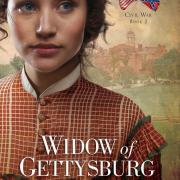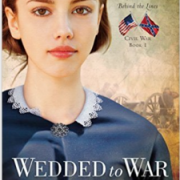The Writing Life: A Single Scene in the Making
In case you've ever wondered why it takes so much time to write a historical novel, allow me to share with you last night's experience as a prime example. Right now I'm working on my third novel in the Heroines behind the Lines series, Yankee in Atlanta. I worked last night from about 5:30pm to 2am, with about an hour break to get the kids into bed. I wrote a single scene. *bashes head onto keyboard* *regains composure* Here's why. I wanted Noah to give Caitlin a shooting lesson before he leaves with the army. Sounds simple enough, right? Well... read on. And between each "Obstacle" just say to yourself "Time passes." Because it did. Ha!
Obstacle #1: Where would you go to give shooting lessons? Away from the city, I decide, to be safe. OK, but where? What does it look like, sound like, smell like? I look at several maps of Atlanta in 1863-4, and see there is a creek about two miles east of the city. Good start, we can put them there. I look up "Sugar Creek, Georgia" using Google Images. Mostly a bunch of real estate comes up, but I do see trees. This makes sense. But what kind of trees, plants, grasses, flowers, etc. were there? I flip through my new book on native Georgia Wildflowers and find descriptions for the Upper Piedmont region. Now I know what the vegetation may have included. But what else? Stone Mountain is close to Atlanta. Could they have seen that in the distance? I look up some more maps, then look up the elevation of Stone Mountain and ultimately decide no, they would not have seen the mountain from where they were. Too bad. Finally, I can see where my characters are, and write:
Out here, away from a city swollen with war and throbbing with nationalism, away from rutted roads that pulsed with people, away from fevered factories and screaming trains, Noah Becker could remember what he had loved most about America. Closing his eyes, he inhaled the pine scent carried by wind that hushed through the trees like a mother to her child. Sugar Creek gurgled and glittered in the sun, the land hugging its banks to it unsullied by man’s progress. The clink of his horse’s bridle, the drone of cicadas, the drilling of a woodpecker from some unseen place—[you can read the rest when it comes out!]
Also: I remember that Carl Schurz, a German revolutionary who emigrated to the U.S. and fought in the Civil War, had a very romantic log-cabin view of American before he came here. I decide my character Noah Becker had a similar sentiment, as a German revolutionary immigrant himself. I decide to say so, since now we're out here away from the city in this scene, and he would have remembered his simplistic vision of America. But I want to remember exactly what it was Carl Shurz said about this. So I look up his Reminiscences on my Kindle and do a search for "log cabin" until I find the passage I'm looking for. Bingo. I write the next paragraph with confidence.
Obstacle #2: I have never fired a gun before, let alone a Civil War gun. How does one do it? Well, first I have to decide on the weapon Noah leaves at home for Caitlin to use. Although I now know how to load and fire a Civil War musket/rifle from last year's research, I decide that he would be taking the rifle with him as a soldier. If he has an extra revolver, he could leave that with her to defend herself and her home. Right, a revolver. What kind of revolver would a Southern man have? How would you use it? I search online for firearm safety tips and find generic common sense things, such as don't store it loaded, don't put your finger on the trigger until you're ready to shoot, etc. OK, but I need something more specific. I go to YouTube and after viewing several unhelpful videos (time passes, time passes) I find a video so brilliant I pinned it to my Yankee in Atlanta Pinterest board. Now I see a revolver (the Kerr) which my character could have used. (I'm saying a Rebel veteran client paid him for his legal services with this gun about a year ago, since Confederate money was so depreciated.) Not only do I get to see the gun, but the guy in the video shows me how to load it AND fire it, I get to see the accuracy of the thing, I see the recoil, what it sounds like...in short, it's a jackpot. For you fellow Civil War enthusiasts, here it is: Problem solved. [UPDATE: I ended up NOT using this gun, because I found a real live Civil War firearms expert who set me straight. Problem solved... again.]
Obstacle #3: When Noah stands behind Caitlin as she's about to fire, he can smell her. But what does she smell like? Soap was a scarce commodity in the South. I pull out two books from my shelf: Ersatz in the Southern Confederacy (a book on Southern shortages and substitutions) and a little booklet on Civil War Herbs and Plants I picked up at one of a few Civil War museums I visited earlier this summer. Neither one is organized very well, so I go fishing for references to soap. [Time passes] In both places, I find that chinaberries made the best soap, and did not require grease. Great! But these books refer to chinaberry soap in Mississippi and Virginia. Were there chinaberries in Georgia? I look in my Georgia Wildflowers book but the index is incomplete and I lose patience. I Google chinaberry and Georgia, and find information that makes me comfortable in saying Caitlin made her own chinaberry soap. That's what she smelled like. Also, the scent is sweet and mild. Problem solved.
Sidetrack: There is an ad on the Google article sidebar for some piece of news, and I click on it because I am woefully behind in current events. (Gee I wonder why.) But it ends up being a huge page of celebrity gossip. I actually spend a moment scanning the headlines, but refrain from clicking on anything that will take me deeper into the abyss. Pull out! I tell myself. Pull out! I close the Web page and return to my Word doc. Those were my three main obstacles last night. Other sidetracks included:
Telling Pandora that "Yes, I'm still listening" so many times I give up and play my own music. I tried the soundtrack to Limitless, the movie about a writer who takes a wonder drug and finishes his book in three days. I spend time wondering, if presented with such a temptation, would I take the pill? Hmmmm....
Posting on Facebook that I am trying to write a sparky (romantically speaking) scene, and then checking back every once in a while to see comments on my post. (Hey, being a writer can get lonely.)
Staring at my fingernails and cuticles
Rolling around on my bouncy ball, pretending I'm giving my core a "work-out" during my moments of writer's block
Rubbing BioFreeze into my right upper back, and onto my right forearm
Looking up various words at dictionary.com to make sure they were in use in 1863
Gazing longingly at the covers of my first two novels and visualizing the day when this book, too, shall be DONE
Snacks. I made a few trips to the kitchen. String cheese, blueberries, brownies. Not all at once.
That was just one scene. I'm not even going to tell you how much time I spent looking for the perfect Greek Revival floorplan for Noah's house before hearing from a historian in Marietta that maybe a plantation plain style would be better for him. Or how long I researched dog breeds that were popular in Georgia homes before and during the Civil War. I'm sure other writers are way faster than me. But this is a glimpse into my process. It is S-L-O-W. But I hope the end result will be a novel you can trust. :)
P.S. I may not be blogging again until the book is done. Now you know why. :)









